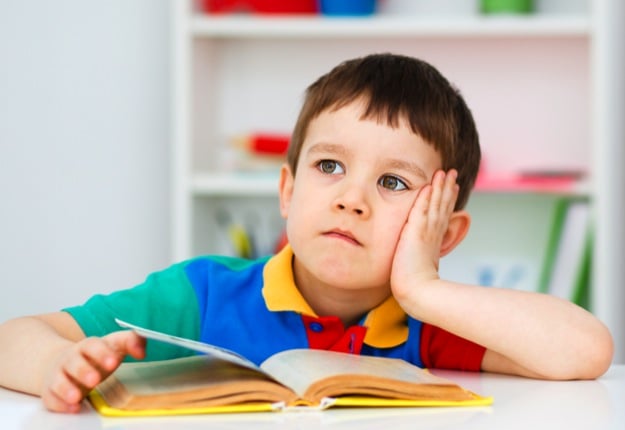1 in 10 Australian children have dyslexia. Is your child one of them?
Most kids with dyslexia don’t realise it – they think everyone else sees what they see.
Most parents have no idea when their child has dyslexia. They mistakenly believe their child is lazy or avoiding school work because they prefer the outdoors.
Dyslexia is fairly straightforward to help, once you recognise it.
In this video… You can actually experience dyslexia for yourself.
Are you ready for this?
So how can you check your child for dyslexia?
The most important question to ask your child: “What are the words doing on the page?”
Ask your child to stare at a white page text for 10 seconds and then ask “what are the words doing on the page?” Don’t put words in your child’s mouth by suggesting what the words might be doing. Just ask them what the words are doing.
If your child tells you the words are moving, blurring out, shaking, look 3 dimensional or disappearing on the page, it’s likely your child has dyslexia.
This is not a comprehensive test, but most children with dyslexia can be picked up just by asking what the words are doing on the page.
5 straightforward tips that help kids with dyslexia
Don’t panic! Dyslexia is much easier to help than most parents realise.
Some easy ways to help with dyslexia are:
1. Ensure that text is large, bold and double spaced.
It will make the text easier for kids to read if the words are moving or fading away.
2. Change the colour of the page.
See if the words stay still on coloured paper. The most common colours that help children with dyslexia are pale blue, pale purple or light grey. If they don’t help, then check other colours.
3. Avoid fluorescent lighting like the plague!
Kids with dyslexia succeed more under natural lighting or yellow lighting than fluorescent lights.
4. Dim your child’s computer screen slightly.
The brighter the background is, the more difficult your child will find it to read text.
5. Chat with your child’s teacher at school.
Make them aware that the words are moving when your child is trying to read.
The key difference between kids who succeed or fail with dyslexia:
The main difference between kids succeeding or failing with dyslexia is how determined their parents are to find ways to help.
When parents give up and assume it’s all too hard to help, their child will suffer.
When parents persevere and try many different avenues to find ways to make learning easier for their child, their kids will succeed in the end.
Where to get help for dyslexia
Okay, so you suspect your child has dyslexia. What now?
The next thing to find out is how much the dyslexia is actually impacting your child’s learning.
Here are some great places to start learning:
Teacher/school: Most schools have at least one teacher who knows a lot about dyslexia and how to help. Track down that teacher.
Optometrist: An optometrist is unlikely to help your child with dyslexia but they can check whether your child is short-sighted or not. Having dyslexia is challenging, but having dyslexia and being short-sighted can be disastrous so definitely get your child’s eyes tested.
Doctor/specialists: Chat with your child’s doctor and find someone who won’t just diagnose dyslexia, but will provide you with straightforward solutions and new skills.
Search the web: So many parents find the help they need on the Internet. The Dyslexia Improvements website is one website that gives free, straightforward video training for parents.
Other mums (of course!): There is a big community of other concerned mums who would love to share their knowledge and ideas with you. You’ll find them on the net, or somewhere in your town.
Do you have a child with dyslexia, how have you helped them cope? Can you share your tips with other mums?






















11:26 am
2:23 pm
8:22 pm
11:45 pm
9:21 pm
6:03 pm
11:31 pm
4:08 pm
3:16 pm
1:07 am
4:39 pm
7:35 pm
7:58 pm
-

-
-
Michael from (Dyslexiaimprovements.com) replied
- 17 May 2015 , 11:29 pm
Reply2:25 pm
3:23 pm
8:07 pm
-

-
-
Michael from (Dyslexiaimprovements.com) replied
- 08 May 2015 , 7:53 am
Reply9:23 pm
-

-
-
Michael from (Dyslexiaimprovements.com) replied
- 08 May 2015 , 7:55 am
Reply4:43 pm
-

-
-
Michael & Suzanne (Dyslexiaimprovements.com) replied
- 01 May 2015 , 9:50 pm
Reply6:38 pm
-

-
-
Michael & Suzanne (Dyslexiaimprovements.com) replied
- 30 Apr 2015 , 8:26 pm
Reply10:59 am
-

-
-
Michael & Suzanne (Dyslexiaimprovements.com) replied
- 30 Apr 2015 , 8:40 pm
Reply- 1
- 2
- 3
- »
Post a commentTo post a review/comment please join us or login so we can allocate your points.